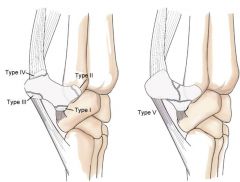![]()
![]()
![]()
Use LEFT and RIGHT arrow keys to navigate between flashcards;
Use UP and DOWN arrow keys to flip the card;
H to show hint;
A reads text to speech;
4 Cards in this Set
- Front
- Back
|
The tendon of which muscle inserts on the accessory carpal bone?
|

Flexor carpi ulnaris muscle.
Type IV accessory carpal bone fracture is an avulsion at the tendon insertion of the flexor carpi ulnaris muscle at the caudoproximal surface of the accessory carpal bone. |
|
|
How are accessory carpal bone fractures classified?
|

Accessory carpal bone fractures are classified into five types.
Types I, II, and III are considered sprain avulsion fractures, but only types I and II are intra-articular. Type I (67%)- Avulsion fracture of the distal margin of the articular surface at the attachment of the ligament from the accessory carpal bone to the ulnar carpal bone. Type Ia - Palmarolateral. Type Ib - Palmaromedial. Type II (13%) - Proximal margin of the articular surface of the accessory carpal bone to the distal radius and ulna. Type III (3%) - Avulsion at the distal surface at the caudal end of the accessory carpal bone. Type IV (12%) - Avulsion at the tendon insertion of the flexor carpi ulnaris muscle at the caudoproximal surface of the accessory carpal bone. Type V (5%) - Comminuted fracture of the accessory carpal bone. |
|
|
Accessory carpal bone fractures occur most commonly in what breed?
|
Greyhound.
Studies of accessory carpal bone fractures have all focused on the racing Greyhound. These fractures occur in the right carpus (80%) in dogs that race on elliptical tracks in a counterclockwise direction. The proposed mechanism of injury is full weight bearing on the right carpus at the racetrack turn when the accessory carpal bone is acting as a fulcrum for the palmar carpal ligaments and the flexor tendons to prevent hyperextension of the carpus. |
|
|
Why do you want to remove articular cartilage when performing an arthrodesis?
|
Articular cartilage inhibits bone growth.
|

